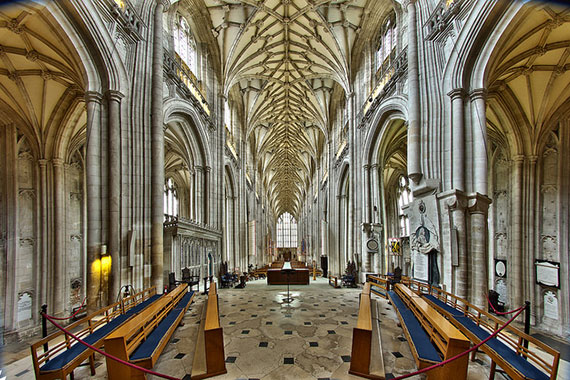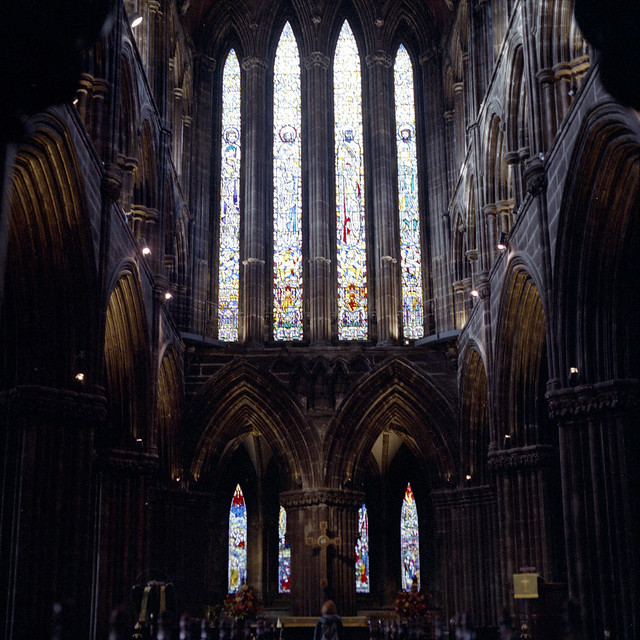Finally, the local photo club had arranged for us to take pictures inside the beautiful Our Lady of Victory Basilica. I was so excited! In my nearly 50 years, I had never once even peeked in through the doorway.

Photo by Steven Vacher; ISO 100, 15-second exposure.
Once inside, I understood why documentaries had been made about this grand church. It was so ornate. Michelangelo could have painted these ceilings. Still, after more than 100 years, the colors were so bold and beautiful they could have been painted yesterday. The marble and gold glistened in the sunbeams.
One big problem, though. It was so dark inside. How was I going to photograph here? The ceilings were much too distant to be affected by flash. That would ruin the delicate colors as well. This problem was compounded by the brightness of the stained glass windows. Sure you could see. But how about the camera?
Fortunately, one of the veteran photographers in our group was kind enough to offer some tips.
- Without using HDR or other multiple exposure techniques, you cannot properly expose both the windows and the room. Choose one or the other.
- The windows are easy because they are so bright. You have full choice of aperture, shutter speed, or ISO. Just know that when you expose properly for the windows everything else will look nearly black.
- If you choose to expose for the room, the windows will be blown out (way too bright). You will want a fairly small aperture to keep everything in focus, f/8 or smaller (bigger number).
- If you don’t want grainy photos, you’ll have to keep your ISO as low as possible: 100, 200, no more than 400.
- That means you’ll have to settle for a slow shutter speed, ½ second, maybe 1 or 2 seconds.
- You really need a tripod to hold the camera steady at those speeds. But if you’re caught without one, a bit of clever snooping will let you find solid surfaces upon which to brace your camera. A bit of pressure against a post, a pew top, pew sides, or the floor will at least let you get some photos.
- Also, you can use your camera’s self-timer to avoid shake from your hands. Frame your shot, set the timer and put the camera down.
The slow shutter speed trick worked miracles! I came home that day with tons of great shots from inside this beautiful church. Memories to last a lifetime.

“glasgow cathedral” captured by Richard P J Lambert
Next time you’re confronted with a dark space that cries out for photos, remember this slow shutter speed trick. You’ll be amazed at the images you can create where once before you imagined there was not enough light.
About the Author:
Robert Schwarztrauber (shutterbugshaman.com) is a photographer, author, speaker, and teacher who provides many online resources to help people lead healthier, happier lifestyles.
Like This Article?
Don't Miss The Next One!
Join over 100,000 photographers of all experience levels who receive our free photography tips and articles to stay current:






Thanks for the very informative post and the follow comment tips. Many churches, cathedrals, etc., here in Ireland don’t allow the use of tripods, (I’ve also found this to be the case in France), so your tip about using solid surfaces to brace the camera is very relevant when using slow shutter speeds for these interior shots.
I have found that I can go to 1600 ISO in churches without getting too much noise. Between 1600 ISO and some post-processing, you can capture some stunning images. I agree with the basic premise of the article though, that slow shutter speeds work well and have the added benefit of keeping ISO and noise lower.
Great photos to go with the article. Hope everyone can benefit from these tips.
Next lesson: White balance. ;^) In a pinch, without your grey card, just about any white object will work. A snap of one of the hymn pages may have worked even with the text printing. Combinations of black and white work just about as well as grey. I’ve also pointed the camera at the light source itself. Other times, when desperate, I will try a black surface or an off-white wall. Sometimes it’s impossible because you have sunlight and various types of lights in different areas and you just have to make a compromise. You really just need to get close and fix in post; if the white balance is too far off, it may be downright impossible.